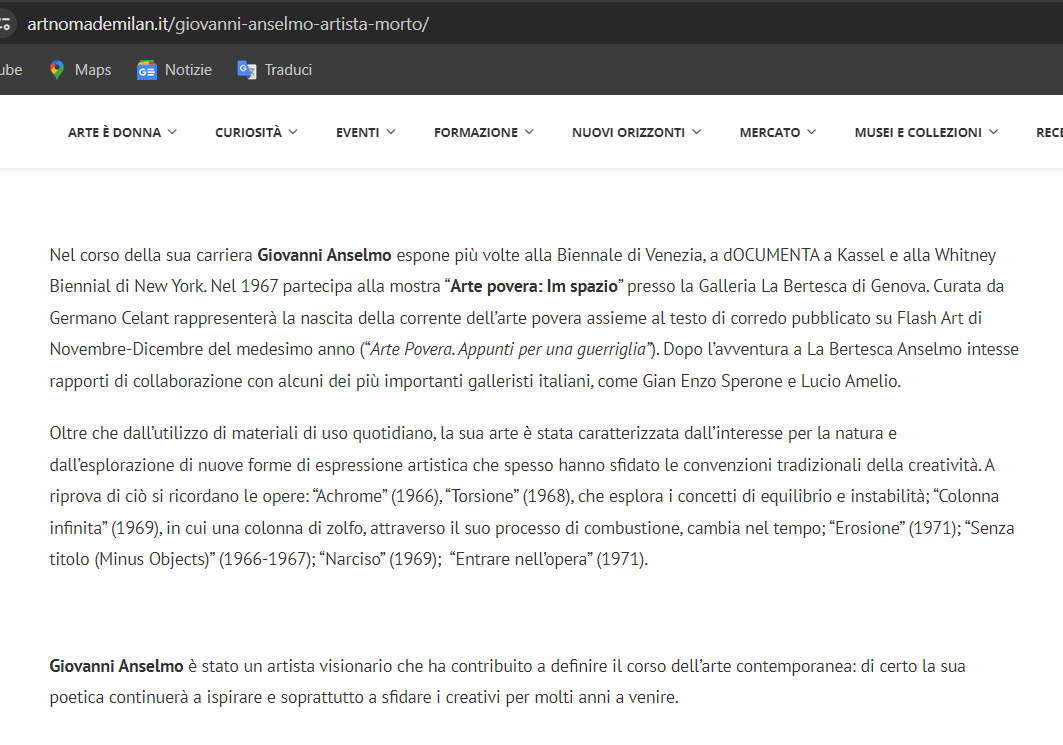Is it possible to upset, in a few lines, the biography of an artist who has just passed away? If it is often newspapers that write inaccuracies on their pages, influencers also run the same risk: this is the case of Art Nomade Milan, aka Elisabetta Roncati, over 100,000 followers on Instagram, one of the most followed art influencers, defined by Marie Claire magazine as “the influencer who saves art through Instagram,” who began experimenting on Threads, Meta’s new social network that last Dec. 14 was also opened to European users: the result, however, takes on decidedly disturbing contours.
In fact, Roncati published in the past few hours on his website artnomademilan.it, relaunching it on Threads, an article on John Anselm, the great Arte Povera artist who passed away just yesterday, filled with inaccuracies and conspicuously incorrect information, easily detectable by anyone with a minimal smattering of knowledge about the art of the 1960s, but decidedly insidious in case they are proposed to an audience that has no knowledge on the subject. “Throughout his career,” writes Roncati, “John Anselm exhibited several times at the Venice Biennale, at dOCUMENTA in Kassel and at the Whitney Biennial in New York. In 1967 he participated in the exhibition ’Arte povera: Im spazio’ at La Bertesca Gallery in Genoa. Curated by Germano Celant it will represent the birth of the arte povera current together with the accompanying text published in Flash Art in November-December of the same year (’Arte Povera. Appunti per una guerriglia’). After his adventure at La Bertesca Anselmo established collaborative relationships with some of Italy’s most important gallery owners, such as Gian Enzo Sperone and Lucio Amelio.” Anselmo participated in both the Venice Biennale and Documenta, but consulting the list of group shows published by the Anselmo Archive there is no record of his participation in the Whitney Biennial. Moreover, he was not part of the roster of artists who took part in the 1967 Bertesca exhibition: in fact, Boetti, Fabro, Kounellis, Paolini, Pascali, and Prini were present for the “Arte Povera” section, and Ceroli, Icaro, Bignardi, Mambor and Mattiacci (who participated in pairs) and Tacchi for the “Im Spazio” section. And again, while it is true that he worked with both Sperone and Amelio, one can hardly put the two collaborations on the same level, since Sperone supported Anselmo from the very beginning (at the Sperone Gallery the Piedmontese artist in fact debuted with his first solo show in 1968, and Sperone again organized one solo show of his each year until 1972, and then hosted him several more times in the 1970s, including in his gallery’s Rome and New York offices, and not to mention the vast number of group shows; at Amelio’s Modern Art Agency, on the other hand, Anselmo exhibited only twice, in 1971 and 1975, in two group shows).
Roncati then writes that: “In addition to the use of everyday materials, his art was characterized by an interest in nature and the exploration of new forms of artistic expression that often challenged traditional conventions of creativity. Evidence of this can be seen in the works: ’Achrome’ (1966), ’Torsion’ (1968), which explores the concepts of balance and instability; ’Infinite Column’ (1969), in which a sulfur column, through its burning process, changes over time; ’Erosion’ (1971); ’Untitled (Minus Objects)’ (1966-1967); ’Narcissus’ (1969); ’Entering the Work’ (1971).” In this list of works, unfortunately, only two of them were actually made by Anselmo, namely Torsione and Entrare nell’ opera. On the other hand, the Achrome series is by Piero Manzoni, the Minus Objects are by Michelangelo Pistoletto, the Infinite Column is a well-known work by Constantin Brancusi (and it is obviously not a “sulfur column” that wears out over time), while no works by Anselmo entitled Erosion and Narcissus appear. The short paper concludes thus, “John Anselm was a visionary artist who helped define the course of contemporary art: surely his poetics will continue to inspire and especially challenge creatives for many years to come.”
Because the generic phrasing, lexical choice (“he helped define” “will continue to inspire and challenge creatives”), and the confusion in attributing works by other artists to a specific author are typical elements of articles written by ChatGPT, are we not in the presence of a piece written through the well-known artificial intelligence application? Hoping to be proven wrong, here is why the operation is worrisome: if an influencer does not verify the information he or she administers to his or her audience , the risk is that he or she will inject into the network many, too many inaccuracies that (as opposed to what happens in a video, where words fly and are difficult to retrieve through searches) can remain there fixed, available to unsuspecting users who perhaps tomorrow will search for information about John Anselm and take for granted the news that he is the author .... of a work by Piero Manzoni.
 Giovanni
Giovanni
 |
| Influencers and jibes: how to slaughter the biography of John Anselm |
Warning: the translation into English of the original Italian article was created using automatic tools. We undertake to review all articles, but we do not guarantee the total absence of inaccuracies in the translation due to the program. You can find the original by clicking on the ITA button. If you find any mistake,please contact us.